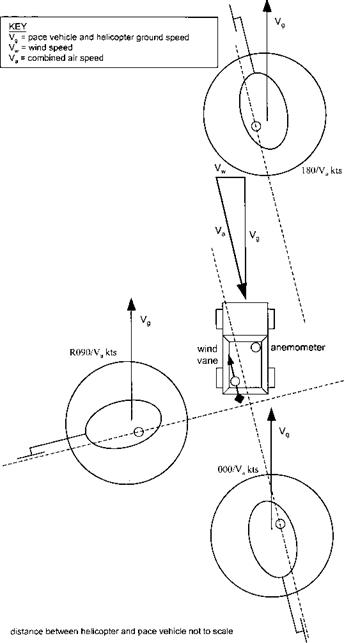Presentation and interpretation of results
Results from the pace vehicle tests will show the trimmed flight control positions for all the relative wind velocities tested. Particularly important results will be any indications of controls approaching limits. The apparent static stability of the aircraft can also be documented from these tests together with details of the pitch and roll attitudes adopted and vibrations experienced. The results must be used with care, however, when considering the handling qualities of the aircraft hovering with winds of different velocities. This is due mainly to the very different visual cues between a ground-referenced hover and formation with a vehicle travelling over the ground at speed. In addition stronger winds are always accompanied by some degree of turbulence which is not replicated by the pace vehicle tests. So if testing using a pace vehicle has been used to generate HQR data like that shown in Fig. 5.27 it must be considered as only a indication of a possible critical azimuth. This would have to be confirmed by appropriate testing in natural winds.
5.7.2 Ride characteristics
The ride characteristics of a helicopter are those qualities that influence the subjective opinion given by the occupants on comfort and pilot workload in turbulence. The characteristics are divided into two distinct areas; gust response and ride quality.
Gust response is the characteristic that governs the way an aircraft behaves in turbulence from the point of view of the pilot. The two factors of which it comprises are the tendency of the aircraft to be displaced from the set flight condition by gusts and the actions needed by the pilot to regain the condition. The type of rotor system, inertia, stability characteristics, and AFCS will all affect the magnitude of any reaction to gusts. The control response of the helicopter will determine the inputs required by the pilot to counter disturbances. In essence gust response is the change in pilot workload to maintain the aircraft attitude in turbulence.
|
Fig. 5.28 Pace vehicle operations. |
Whilst gust response can only be determined by the pilot, ride quality can be determined by any of the occupants. Ride quality is a measure of the comfort or otherwise that the crew and passengers experience in flight. It is clearly closely linked to the same factors that affect gust response (less control response), together with vibration. Ride characteristics as a whole can have a significant effect on the performance of the crew over a protracted period.
5.7.3 Mission task elements
The concept of mission task elements (MTEs) was introduced by ADS-33 as a means of proving that the designed-in characteristics of a rotorcraft actually provide Level 1 handling qualities when conducting role-relevant tasks. The definition of MTEs and of the associated tolerances is the responsibility of the procuring agency, and the choice depends on the intended role of the aircraft. ADS-33E [5.2] contains a number of definitions of MTEs which are designated as flight test manoeuvres. Although these all have role relevance to combat rotorcraft, they are specifically designed to facilitate testing against the quantitative (dynamic response) criteria of the Standard. ADS-33E offers precise definitions of all the MTEs together with default task tolerances.
The specification document divides the MTEs into three categories depending on the visual conditions under which the task will be performed. These categories are tasks in a Good Visual Environment (GVE); tasks in a Degraded Visual Environment (DVE); and tasks in Instrument Meteorological Conditions (IMC). Each task is further categorized by the level of agility required by a rotorcraft to accomplish it: these agility levels are Limited, Moderate, Aggressive, and Target Acquisition and Tracking. Guidance is given within the document on which tasks are appropriate for use with aircraft in the Attack, Scout, Utility, or Cargo roles. Some MTEs are also indicated as suitable for externally slung load operations. The MTEs included in ADS – 33E are mainly concerned with battlefield helicopter manoeuvres but research is underway into developing MTEs for other roles. For example, a deck-landing task is being developed which requires the pilot to conduct a lateral translation and then to follow a target which moves up and down a pole. This brings out the point that an MTE does not have to be totally realistic in comparison to an operational task, it merely needs to require a similar aircraft response that will uncover any deficiencies in handling qualities.
ADS-33E gives guidance on how the MTEs should be flown and used. Each MTE should be flown by a minimum of three pilots with the HQRs awarded being averaged. Pilots are allowed to practise each manoeuvre as many times as necessary to eliminate any learning curve. The task performance can be judged by either the crew or outside observers; in both cases the test pilot should be advised of the accuracy achieved before the HQR is awarded. The division of responsibility for monitoring task performance between crew members should be defined and briefed prior to the tests. The set MTEs listed in the Standard are intended to be flown at the same level of aggressiveness relative to the capabilities of each rotorcraft. In other words the dimensions of the course will vary depending on the characteristics of the aircraft under test. It may also be necessary to change the course layout to take into account the wind on the test day.
MTEs have been employed effectively during handling qualities assessments of aircraft which predate ADS-33E. In such cases it is unrealistic to expect the aircraft to display level one qualities consistently but by using these tasks it is possible to identify deficiencies quickly. Thus knowledge of the standard MTEs and the ability to devise new ones is an essential skill of test personnel.












